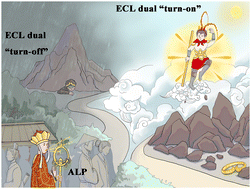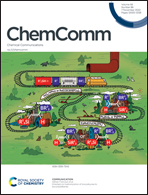An electrochemiluminescence dual “turn-on” strategy for alkaline phosphatase detection using a dual quenching Ru(bpy)32+ encapsulated zeolite imidazole metal organic framework†
Abstract
An electrochemiluminescence dual “turn-on” strategy is first designed to detect alkaline phosphatase (ALP) using a dual quenching Ru(bpy)32+ encapsulated zeolite imidazole metal organic framework (Ru(bpy)32+@ZIF-90). Resonance energy transfer (ECRET) makes ECL “turn-off”. Ascorbic acid 2-phosphate is hydrolyzed into PO43− and ascorbic acid (AA) by ALP. PO43− decomposes Ru(bpy)32+@ZIF-90 and AA prevents ECRET, which makes ECL “turn-on” again.



 Please wait while we load your content...
Please wait while we load your content...